
7 Ways to Understand What Visual Arts Are
Visual arts are those that are perceived mainly through vision. The artistic result is assessed based on the images created.
To understand, evaluate and interpret visual art, it is essential to observe it.
Among the artistic genres are: painting, sculpture, engraving, cinema, photography, architecture and design.
1. Van Gogh: The Starry Night (1889)
Painting is considered the most respected type of visual art in the West.
Since ancient times, painting with paint on fabric has been a means of expressing feelings and ideas. It is a technique that is still used today, allowing people from all corners of the world to express the most varied emotions and thoughts.
The frames contain images that give us a powerful visual impact, thanks to their colors, textures and shapes.
Vincent van Gogh, a Dutch artist, created the famous work Starry Night. This painting is an example of his creativity.
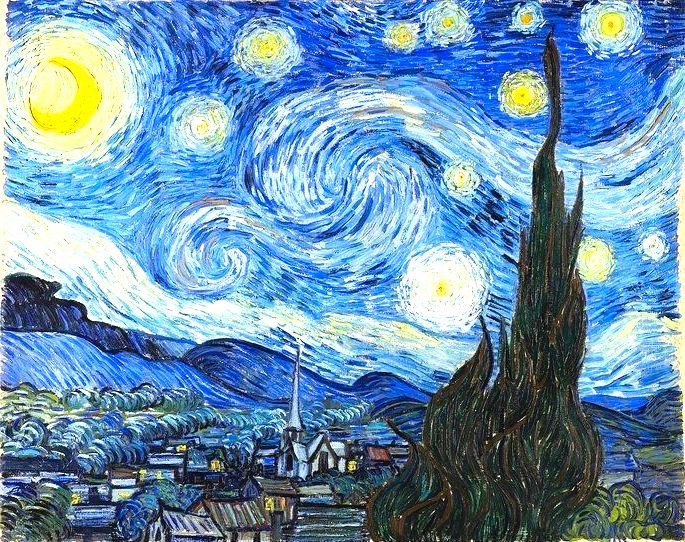
starry night painting by van gogh
When looking at the canvas, created in 1889, a night landscape comes into view, with a vast sky full of spirals. A cypress tree in the shape of a flame rises into the sky.
Van Gogh was admitted to the Saint-Rémy-de-Provence psychiatric hospital and the scene shows the view from his bedroom window.
Through vigorous brushstrokes and spiral shapes, the work expresses the agitation of feelings that the artist carried. It is possible to feel the turmoil of emotions he was going through.
2. Glass Tears (1932) by Man Ray: A Photograph
Since the first half of the 19th century, photography has been consolidating itself as an aspect of the visual arts. Initially, it was seen as a scientific method of reproducing images, rather than art itself.
Quickly, someone's enormous inventive capacity was noticed, and the person came to be considered an artist.
From the vision, the appreciation of art was established as visual art.
Man Ray was an artist who revolutionized the way we see photography. The North American used the technique to create highly successful surrealist works.
Glass Tears, also known as Glass Tears, was captured in 1932.
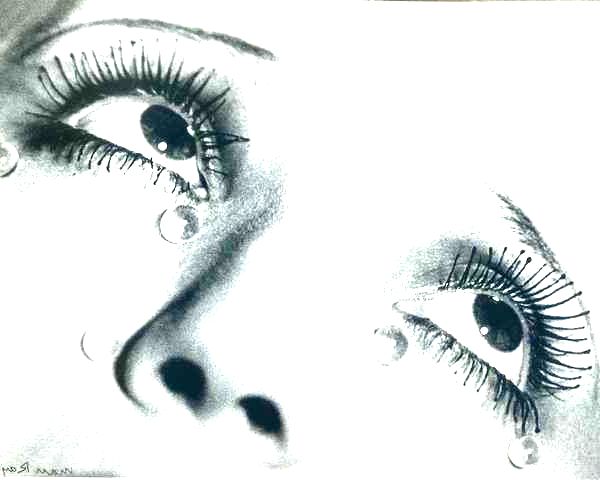
Photography Glasse Tears, by Man Ray, shows a woman with glass tears on her face and eyes looking up
The cinematic narration is reflected in the image of a female character with tears rolling down her face. Her eyes, marked with eyelashes, look at something above, which leaves us intrigued as to why she is so sad.
3. The Cabinet of Dr. Cinema
Visual art can be experienced through cinema, as vision is one of the most important senses for enjoying the cinematic experience. This happens because cinema is an artistic language that emerges from photography.
Cinema emerged at the end of the 19th century, when extremely short silent films were produced, lasting less than a minute.
As time passed, cinema gained new features that allow viewers to have a more immersive experience. Through the 3D technique, it is possible to create the feeling that the audience is inside the story that is being told.
An obligatory reference in the history of cinema, The Cabinet of Dr. Caligari (1920) deserves to be highlighted.
Robert Wiene is the director of this film, a classic of German expressionism. Its content is full of intriguing narratives, with dramatic and contrasting aesthetics.
Featuring exaggerations, angled framing and a ghostly atmosphere, the expressionist movement seeks to portray anguish and maladjustment in the context between the two world wars.
4. Ron Mueck: "Baby" Sculpture (2020)
Since prehistoric times, sculpture has been an art developed with the creation of figurines made from different materials, such as ivory, bones, stones, among others.
Art served many ancient civilizations to express their worldviews, representing mythological and historical scenes.
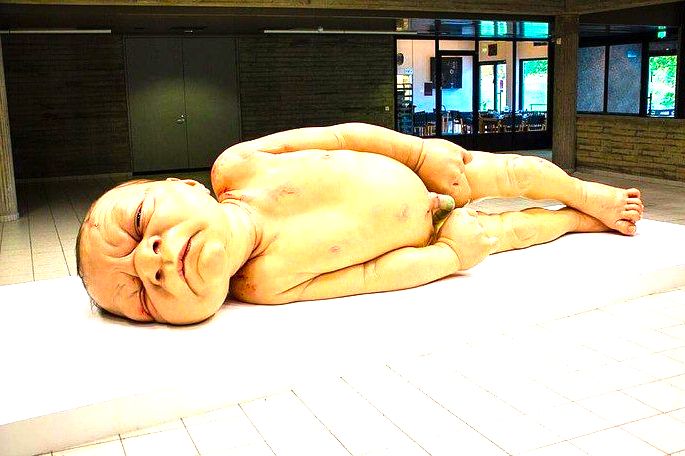
Sculpture remains a relevant artistic language, even with the emergence of new techniques. This is an art in which vision is essential for understanding, but touch can also be excited.
giant newborn sculpture by Ron Mueck
Ron Mueck, a contemporary Australian artist, has some stunning work.
Baby (2000) is an impactful work of sculpture that presents us with a newborn baby created in an ultra-realistic way. When contemplating the work, the viewer is invited to reflect on the human body and the meaning of life.
5. Engraving: J Field Workers
Engraving encompasses a set of techniques that allow you to create drawings using rigid structures as a base.
Wood engraving is one of the oldest and most popular methods of art. The artist creates the matrix by making deep cuts in a wooden board. Then, a thin layer of ink is applied to the matrix and it is pressed onto paper for printing.
In the northeast of Brazil, there is strong use of the technique of illustrating cordel literature with contrasting images.
woodcut by J. Borges of rural workers
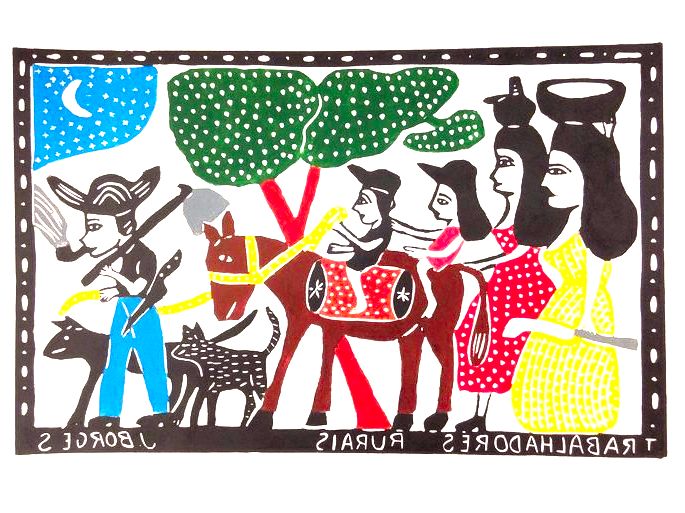
J. Borges is a renowned Brazilian woodcut artist. His works display themes from the backlands, portraying people's lives and their habits, such as, for example, rural workers.
6. Lina Bo Bardi and her Characteristic Architecture: Glass House from the 1950s
Architecture is an art form that, through the construction of buildings, creates spaces for people and supports various human activities.

For a work to be considered art, it must have aesthetic and plastic concerns. These are generally assessed through vision, making it an aspect of visual art.
Casa de Vidro, located in São Paulo, is an emblematic work of modern Brazilian architecture built in the 1950s by renowned architect Lina Bo Bardi. It is considered a striking example of modern architecture.
7. Marianne Brandt and Her 1924 Tea Infuser Design
Design refers to the creative process of building objects with a combination of form, aesthetics and function in mind. These products are generally mass-produced on an industrial scale to make them affordable and practical.
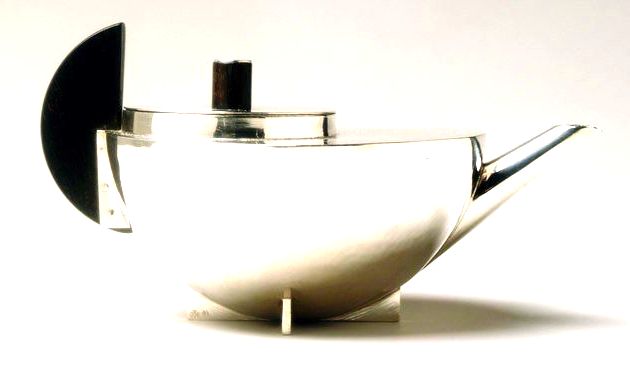
In the 1920s, the Bauhaus School, in Germany, was created with the aim of encompassing different forms of art, including design.
Tea Infuser, and Marianne Brandt
Marianne Brandt, a Bauhaus woman, stood out in design when she created, in 1924, the Tea Infuser with a modernist design. Her work is still considered innovative to this day.

- July 27, 2024
An Imaginary Interview with Auguste Rodin

- July 27, 2024
Drawing Cartoon Faces

- July 27, 2024
Gallery of Calligraphy by Ali Rezaeian - Iran

- July 27, 2024
Ali Rezaeian

- July 27, 2024
Gallery Of Humor Drawing By Mo Qasem - Netherland

- July 27, 2024
Gallery Of Illustration By Simon Letch - USA

- July 27, 2024
Gallery Of Humor Drawing By George Riemann - Germany

- July 27, 2024
Gallery Of Humor Drawing By Becs - Argentina

- July 26, 2024
Gallery of Humor drawing by Ray Costa - Brazil

- July 25, 2024
The boost from private collectors to La…

- July 23, 2024
The Macla works landed in Mar del Plata

- July 21, 2024
Art in paint, leather and wood adorns t…

- July 21, 2024
New art exhibition adorns the Cañase Cu…

- July 21, 2024
Celebrating the talents of women in Lat…

- July 21, 2024
Malba named the permanent collection sp…

- July 20, 2024
First International Mail Art Biennial 2…

- July 20, 2024
Center Pompidou's first branch in Latin…

- July 11, 2024
Exhibition “Alberto Ulloa: My collectio…

- July 11, 2024
98 works of contemporary art from the U…

- July 07, 2024
The news and highlights of the craft fa…

- July 07, 2024
Ecuadorian artist with a global and hum…

- July 06, 2024
Art Fair in La Rampa in Cuba

- July 04, 2024
Two works by master Carlos Jacanamijoy …

- July 03, 2024
Art, creativity and fun at the Oscar Ni…

- July 03, 2024
Newly discovered rock art in Venezuela

- July 02, 2024
One of the largest urban art galleries …

- July 02, 2024
The largest craft fair in Latin America

- June 30, 2024
Bolivia mourns the death of Édgar Arand…

- June 30, 2024
Writing with light

- October 08, 2023
Illustrations reflect the brutal Israel…

- December 25, 2023
The jury statement of the Iran-Brazil F…

- July 29, 2023
History of Caricature in Brazil

- April 20, 2024
Poignant Image of Grief Wins Mohammed S…

- September 01, 2023
Neural Filters in new photoshop 2023

- October 21, 2023
Erick Meyenberg and Tania Ragasol at th…

- March 14, 2024
museum of statue of van gogh

- August 09, 2023
Venezuela mural expresses solidarity wi…

- March 30, 2024
illustration websites in Latin America

- May 20, 2024
Latin American Festival of Performing A…

- March 15, 2024
museum of sculpture of Salvador Dali

- March 21, 2024
The history of art in Palestine

- October 30, 2023
Palestinian turns images of the Gaza co…

- March 14, 2024
OpenAI Announces New Leadership

- December 01, 2023
Latin American International Graffiti F…

- April 25, 2024
Latin American art at the Venice Bienna…

- June 24, 2024
The urban art that lives in Lima

- April 22, 2024
Microsoft was recently hit by a 'Mike-r…

- June 29, 2024
Exhibition at Centro MariAntonia contra…

- October 23, 2023
Photos by José Luis Díaz of the march o…

- October 08, 2023
Illustrations reflect the brutal Israel…

- December 25, 2023
The jury statement of the Iran-Brazil F…

- November 06, 2023
Heba Zagout: Palestinian artist murdere…

- October 23, 2023
Controversy over the project that will …

- October 30, 2023
Palestinian turns images of the Gaza co…

- September 01, 2023
Neural Filters in new photoshop 2023

- February 06, 2024
Bolivian artists will be at the 2024 Ve…

- July 30, 2023
Havana Biennia contemporary art exhibit…

- July 29, 2023
Piracicaba International Humor Exhibiti…

- February 18, 2024
7 Ways to Understand What Visual Arts A…

- November 17, 2023
Fernando Botero's work is booming after…

- February 08, 2024
Art Week 2024 in CDMX

- December 10, 2023
Sliman Mansour and Palestinian art on t…

- October 17, 2023
The influence of Latin American artists…

- October 25, 2023
Art in Resistance for Palestine

- December 14, 2023
Green manifesto: art as a bridge betwee…

- August 12, 2023
The best photos in the world taken with…

- February 29, 2024
STAR+ PRESENTS A PREVIEW OF “FINE ARTS”

- July 29, 2023
History of Caricature in Brazil

- November 09, 2023


